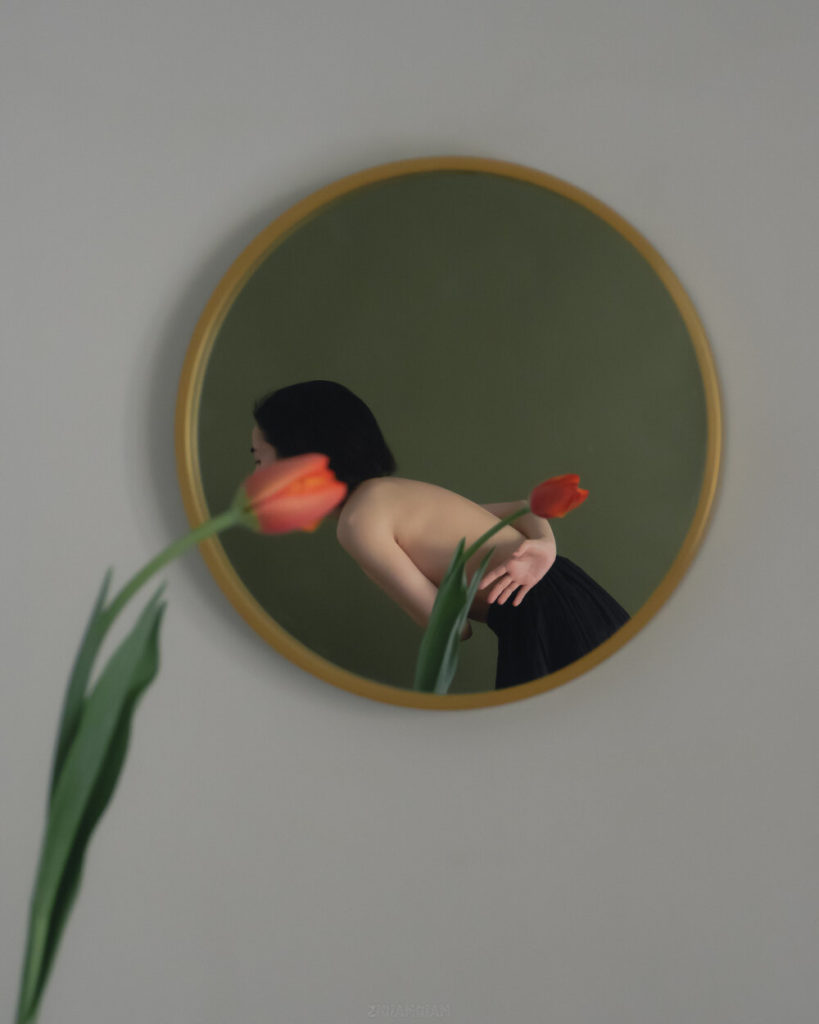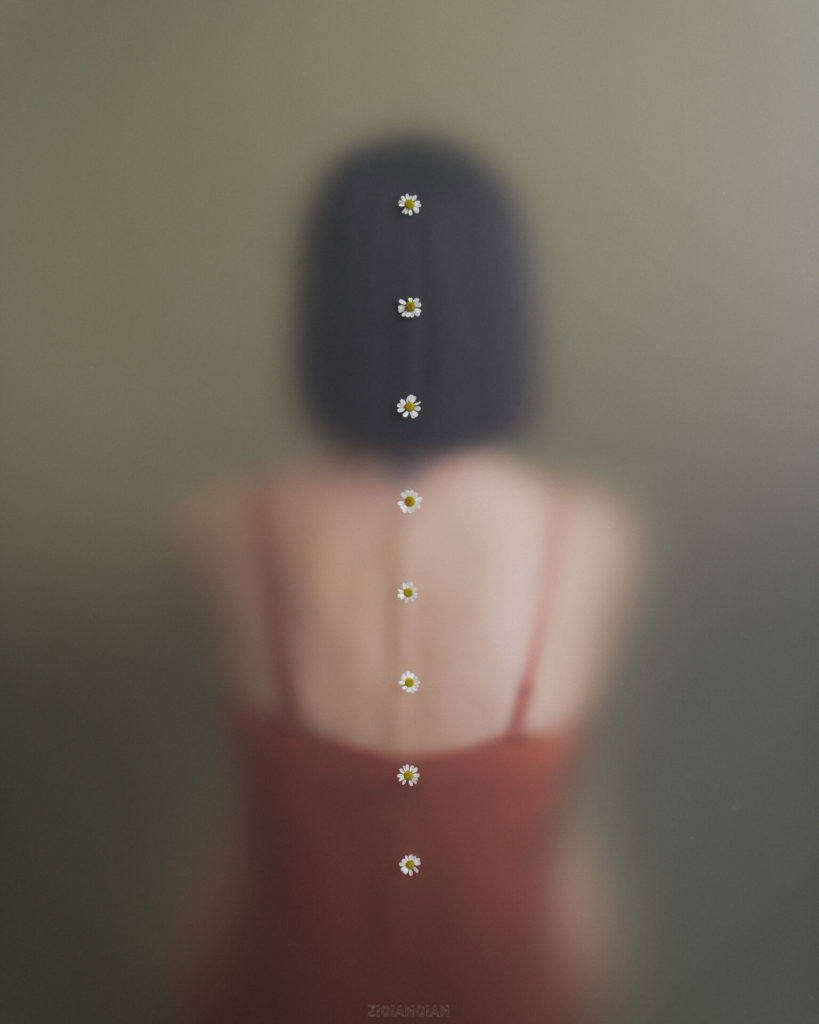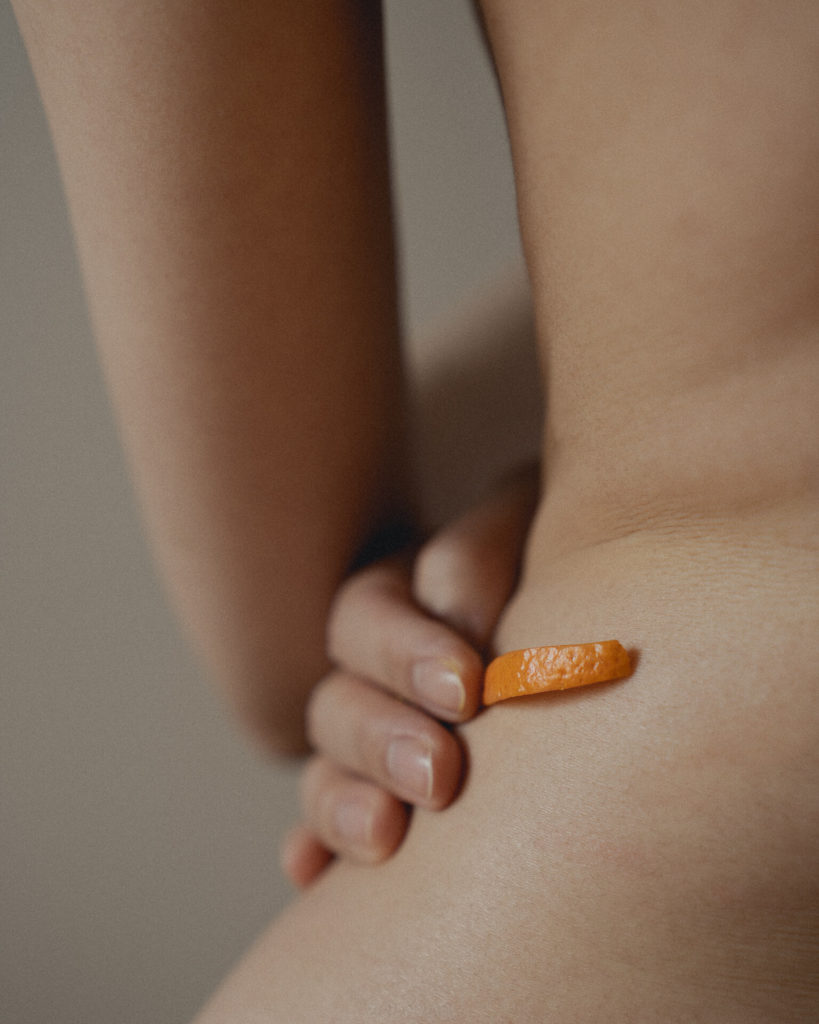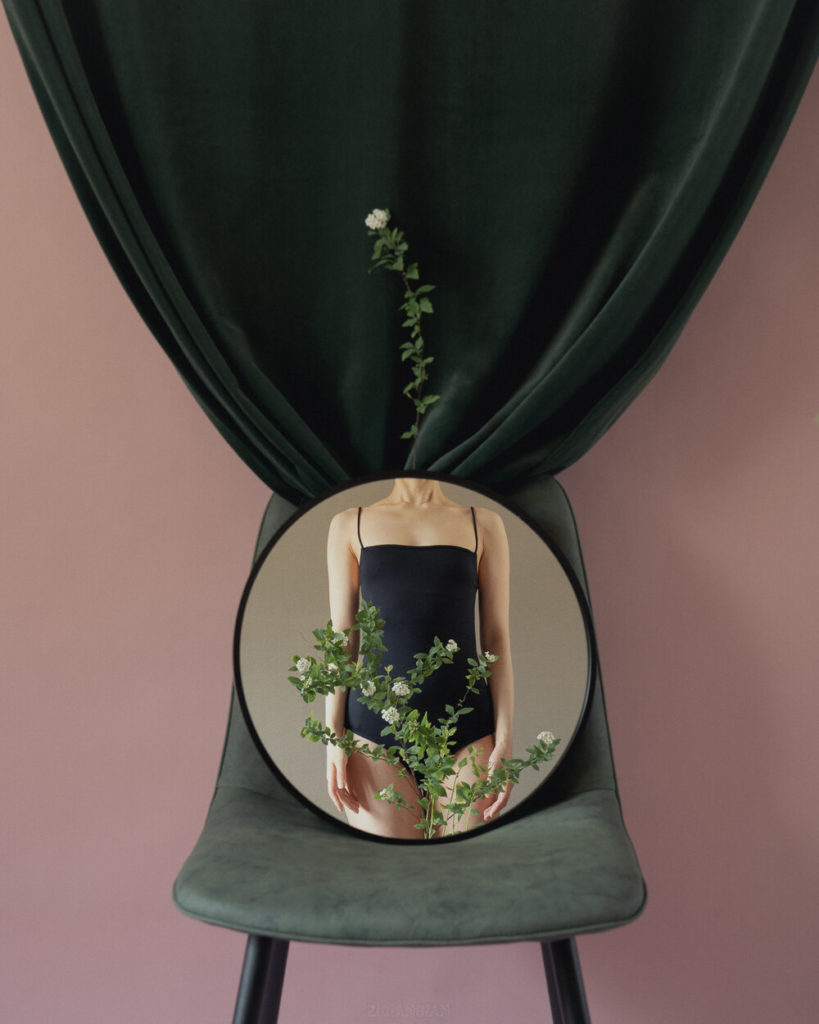ACA project a le plaisir de publier un essai de Paula Tomasini Collado sur le travail photographique de Ziqian Liu. Paula est étudiante Erasmus (Barcelone) en Histoire de l’Art à l’Institut Catholique de Paris.
ACA project is delighted to publish Paula Tomasini Collado’s research paper on Ziqian Liu‘s photography. Paula is an Erasmus student at the Catholic Institute of Paris studying Art History.
Les photographies de Ziqian Liu, une conception Taoïste de la relation du corps avec la nature ?

Instagram ; Cette plateforme qui, comme toutes, est une fenêtre vers le monde, ou du moins une partie de celui-ci… Grâce à cette application photos, les artistes contemporains parviennent à toucher plus de gens, en s’éloignant des moyens plus conventionnels de se promouvoir. J’ai moi-même été victime de cette publicité secrète, bien que très agréablement. C’est ainsi que j’ai pu découvrir les œuvres de la photographe Ziqian Liu, une artiste chinoise autodidacte qui fait des autoportraits chez elle. J’ai tout de suite été attirée par la subtilité de sa photographie qui réside dans le minimalisme de ses compositions. Compte tenu du manque d’analyse des concepts qui sous-tendent le travail de Ziqian Liu, j’ai décidé d’apporter mes propres réflexions. Peu à peu, j’ai réalisé que l’aspect NATUREL de son travail pouvait être lié à une certaine ancienne philosophie chinoise; la philosophie du Tao.
Bien que ces sujets ne semblent avoir aucun rapport, cette petite enquête tentera de prouver le contraire: Pour cela, il faut commencer par l’analyse visuelle de son travail. Comme mentionné, ses photographies sont toutes des autoportraits. Pourtant, il y a une forte contradiction: ce sont des autoportraits sans identité. Son visage est toujours effacé ou caché, parfois par des objets (figure 1). En effet, sa figure est souvent encadrée de miroirs circulaires qui peuvent évoquer une fenêtre d’où elle perçoit le « monde intérieur », ce qu’elle mentionne dans ses interviews1. D’autres fois, c’est l’utilisation d’une flaque d’eau qui altère la perception du corps ou encore l’usage de ce qui ressemble à des panneaux opaques, créant un effet de flou (figure 2). Une dernière configuration utilisée par l’artiste pour se masquer est l’usage des plans détaillés, en particulier dans sa série Skin (figure 3).
Par conséquent, le spectateur n’aura jamais de vue directe de sa peau sans intermédiaire (outils, objets, matières). Ce corps non identifié s’entremêle avec différents éléments naturels, habituellement des plantes, (figure 1, 2, 4 et 5) ou des fruits (figure 3 et 4). Les postures font alors écho aux torsions végétales (figure 1), et les plis corporels sont adaptés aux formes naturelles (figure 3). Parfois les fruits et fleurs sont même métamorphosés avec le corps, en simulant ses extrémités (figures 4 et 5). Dans ses œuvres, elle essaie donc de trouver un équilibre harmonieux entre l’homme et la nature2. Ces éléments naturels sont au coeur du travail de Ziqian Liu, puisqu’ils constituent les couleurs les plus vives de l’image. Ce contraste se produit par l’utilisation de teintes assez douces pour les fonds, qui vont principalement du vert au rose, éclairés par une lumière entièrement naturelle.
L’artiste utilise également des éléments quotidiens faisant partie de son environnement, comme des chaises (figure 5), des vases ou des tables (figure 4), en plus des miroirs. Tous aident les composants naturels à se démarquer.
Alors, comment peut-on relier le travail de Ziqian Liu à la philosophie taoïste? La clé se trouve dans le mot «Naturel»: La conception chinoise de la nature est à l’opposé de celle de l’Occident ; Si ce dernier a toujours essayé de la maîtriser en l’urbanisant à travers sa technologie, l’autre a essayé de se métamorphoser, parce qu’il a compris qu’il provenait d’elle et qu’il est incapable de la contrôler. Cette conception taoïste a fortement influencé l’art chinois, en particulier la peinture paysagiste.
Le mot Tao signifie chemin en chinois. Par conséquent, le taoïsme serait un chemin philosophique que nous devons entreprendre individuellement. Les fondements du taoïsme ont été développés par la pensée du philosophe Lao Tseu (VI av. J.-C.) dans son travail (attribué) philosophique-poétique intitulé Dao de jing. Ce petit livre divisé en 81 chapitres commence par une phrase qui résume son principe :
« Le tao qui peut être exprimé par la parole n’est pas le Tao éternel. Le nom qui peut être nommé n’est pas le Nom éternel. (L’être) sans nom est l’origine de l’univers; et par son nom, il est la mère de toutes choses. »3
Nous sommes donc confrontés à une philosophie qui croit en quelque chose d’universel, auquel nous n’avons accès qu’à une petite partie à travers la parole. C’est une relation entre le macrocosme et le microcosme. Selon Lao Tseu, les sages qui ont accompli le Tao peuvent vivre en harmonie constante avec le cosmos et la nature. Pour cela, on doit se débarrasser de la chair substantielle et laisser l’ego derrière pour profiter d’une vie de calme et de tranquillité identifiée à la Grande Nature.

Bientôt ces idées entrèrent dans l’art. La nature joue un grand rôle, et donc l’esthétique prend de l’importance. Le fait de considérer le paysage comme axe central de l’œuvre artistique déplace les thèmes anthropocentriques et religieux, et rappelle à l’être humain sa place dans le cycle de vie4.
C’est au cours de la dynastie Song (950-1279) que le concept de ch’i (esprit) lié à la nature a été élaboré; à présent, une personne et un arbre ont le même esprit5. Pour cette raison, l’Empereur Huizong a inauguré le genre « mineur » des Oiseaux et des Fleurs, où de petits éléments couvrent la majeure partie de la représentation, déformant ainsi perspective et points de vue. À travers un petit détail, nous pouvons alors voir toute la nature vivant en simplicité et en harmonie6. Les artistes taoïstes de la dynastie Song étaient ceux qui, grâce à l’encre de Chine, ont pu montrer leur sensibilité et leur âme, touchée par les formes naturelles.
Le travail de Ziqian Liu semble poursuivre cette tradition à certains égards :Le naturel surpasse l’artificiel. Comme nous l’avons mentionné, dans ses autoportraits les éléments créés par l’homme sont simplement des accessoires qui aident à appuyer l’essentiel ; le corps de l’artiste est lié à des éléments de la nature. Ainsi, les tiges de plantes et de fleurs ressemblent à des colonnes vertébrales (figures 1 et 2), renvoyant à la phrase de Huizong : « Les montagnes apportent la protection, les rivières donnent l’énergie vitale, l’océan offre l’extension et la terre soutient ». Le naturel est également présent par l’éclairage qu’elle utilise et dans les tons chromatiques verts et roses, rappelant la couleur de la terre et des plantes.
La déformation de la réalité dans son travail n’est pas vaine :
Comme dans le genre des Oiseaux et des Fleurs, les détails naturels apparaissent disproportionnés et altèrent la perspective. En ressemblant à ses postures corporelles, ils symbolisent alors la possession du même ch’i que Ziqian Liu. Ce sont alors des microcosmes qui appartiennent au macrocosme. Le miroir collabore à cette distorsion de la réalité: le corps est représenté de manière intangible ce qui rejoint l’idée de Lao-Tseu, à savoir s’éloigner de la matérialité corporelle pour atteindre une vie harmonieuse avec la nature. D’autre part, le miroir est l’outil permettant de comprendre que nous sommes entrés dans le monde de l’artiste, un monde où nature et sentiment sont étroitement liés, rappelant les peintres paysagistes chinois de la dynastie Song.
Cette non-matérialisation du corps se traduit aussi dans la question de l’identité : nous ne reconnaissons aucun visage dans les autoportraits de Ziqian. Le but étant que tout spectateur puisse s’identifier à la figure présentée, l’autoportrait fait alors fonction de « pluriportrait ». Cela peut évoquer la force individuelle nécessaire pour arriver au Tao, tout en ayant conscience de sa présence en nous puisque nous sommes des êtres naturels. Ziqian Liu nous encouragerait donc à chercher cet état d’harmonie et de paix, du corps avec la nature, en ne montrant pas son visage. De cette manière, n’importe qui peut aspirer à atteindre cette dynamique supérieure. L’artiste veut nous montrer que cet état symbiotique fait désormais partie de son quotidien en réalisant ses autoportraits dans son espace personnel, en utilisant des objets habituels.
Nous avons ainsi tenté d’analyser brièvement le travail photographique de Ziqian Liu qui incarne en quelque sorte une philosophie dont la conception est très éloignée de notre époque. Le taoïsme se manifeste dans la relation entre le corps et les éléments naturels, mais surtout dans le calme intérieur. Voilà ce qui définit et se transmet le mieux dans ces autoportraits.
J’ai envoyé cette analyse à l’artiste, elle s’en est retrouvée émue. Il est intéressant de constater que les cultures du passé ne sont pas aussi éloignées que nous le pensons, et font souvent déjà partie de notre bagage culturel. Plus curieux encore, ces autoportraits ne montrent pas la réalité de l’artiste, sinon son aspiration ; Une aspiration à vivre une vie harmonieuse, ordonnée et tranquille.
Essai de Paula Tomasini Collado / Relecture par Amandine Vabre Chau

Ziqian Liu’s photography, a Taoist conception of the body’s connection with nature? [ENG Version]
Instagram; A platform which, like all social media, is a window to the world, or at least part of it… Thanks to this app, contemporary artists are now able to reach more people, moving away from the more conventional means of promoting themselves. I myself have been a victim of this secret publicity, albeit very pleasantly. This is how I came across the work of photographer Ziqian Liu, a self-taught Chinese artist who makes self-portraits at home. I was immediately captivated by the subtlety of her photography, which lies in the minimalism of her compositions. Given the lack of concept analysis on Ziqian Liu’s work, I decided to contribute my own thoughts. Gradually, I realised that the NATURAL aspect of her work could be linked to a certain ancient Chinese philosophy; the Tao philosophy.
Although these matters seem to be unrelated, this study will try to prove the opposite: To do this, we must start with a visual analysis of her work. As mentioned, her photographs are all self-portraits. Yet there is a great contradiction: they are self-portraits without identity. Her face is always erased or hidden, sometimes by objects (figure 1). Indeed, her figure is often framed by circular mirrors that could evoke a window from which she perceives the ‘inner world’, a subject she mentions in her interviews1. Other times, it’s the use of puddles of water that alters the perception of the body, or the usage of what seems like opaque panels, creating a blurred effect (figure 2). A final configuration used by the artist to mask herself is detailed framing, particularly in her Skin series (figure 3).
Consequently, the viewer will never have a direct view of her skin without intermediaries (tools, objects, materials). This unidentified silhouette intertwines with different natural elements, usually plants (figure 1, 2, 4 and 5) or fruits (figure 3 and 4). The postures then echo the organic torsions (figure 1), and the body’s creases are adapted to the natural forms (figure 3). Sometimes fruits and flowers are even transformed with the body, simulating its extremities (figures 4 and 5). In her art, she thus tries to find a harmonious balance between man and nature2. These components are at the heart of Ziqian Liu’s work, as they constitute the brightest colours in the image. The contrast is achieved by using fairly soft tones in the background, usually ranging from green to pink, lit entirely by natural light.
The artist also utilizes everyday items that are part of her environment. Such as chairs (figure 5), vases or tables (figure 4), in addition to mirrors. All these help natural details stand out.

So how can Ziqian Liu’s work be linked to Taoist philosophy? The key lies in the word « natural »: The Chinese conception of nature is at the opposite of the West’s; while the latter always tried to master it by technological urbanisation, the former has transformed itself, understanding nature to be its source and uncontrollable. This Taoist conception has strongly influenced Chinese art, especially landscape painting.
The word Tao means path in Chinese. Therefore, Taoism would be a philosophical route that we have to undertake individually. The foundations of Taoism were developed by the philosopher Laozi (6th century BC) in his (attributed) philosophical-poetic work entitled Dao De Jing. This small book divided into 81 chapters begins with a sentence that summarises its principle:
« The Dao that can be told is not the eternal Dao. The name that can be named is not the eternal name. The nameless is the origin of the universe; and by its name, mother of all things. »3
We are faced with a philosophy that believes in something universal, to which we have access to only a small part through language. It’s a relationship between the macrocosm and the microcosm. According to Laozi, sages who have achieved the Tao can live in constant harmony with the cosmos and nature. To do this, one must rid oneself of substantial flesh and leave the ego behind to enjoy a life of calm and tranquility identified as Great Nature.
Soon these ideas came into art. Nature plays a significant role, therefore aesthetics start to gain importance. Seeing landscape as the central axis of artistic work displaces anthropocentric and religious themes, reminding humans of their place in the cycle of life4.
It was during the Song Dynasty (950-1279) that the concept of ch’i (spirit) in relation to nature was developed; now a person and a tree have the same spirit5. For this reason, Emperor Huizong inaugurated Birds and Flowers, a « minor » genre, where small elements cover most of the picture, distorting its perspective and viewpoints. Through a small detail, we are able to see the whole of nature living in simplicity and harmony6. Song Dynasty’s Taoisit artists were the ones who, thanks to Chinese ink, managed to show their sensitivity and their soul, touched by natural forms.
Ziqian Liu’s work seems to follow this tradition in some respects: the natural overrides the artificial. As mentioned, the man-made components are merely props to support the essential; the artist’s body is connected to herbal elements. For example, the stems of plants and flowers resemble spinal columns (figures 1 and 2), echoing Huizong’s phrase: « Mountains provide protection, rivers give vital energy, the ocean offers extension, and the earth sustains ». Nature is also present through the lighting she uses and in the green / pink chromatic tones, recalling the colour of the earth and plants.

Distortion of reality in her work is not idle:
As in the Birds and Flowers genre, organic details appear disproportionate, distorting the perspective. By mimicking her body postures, they thus symbolise the possession of the same ch’i as Ziqian Liu. As a result, they are microcosms that belong to the macrocosm. The mirror contributes to the distortion. The body being depicted in an intangible way is in line with Laozi’s idea of moving away from flesh materiality to achieve a harmonious life with nature. On the other hand, this object is also the tool leading us to understand our entering of the artist’s world. A world where nature and emotion are closely interwoven, reminiscent of the Chinese landscape painters of the Song dynasty.
This non-materialisation of the body is also transposed on identity: no faces are recognisable in Ziqian’s self-portraits. The intention being that any viewer would be able to identify with the figure presented, the self-portrait thus becomes a « multi-portrait ». It can suggest the individual strength needed to reach the Tao, all the while being aware that it is already present in us, as we are essential beings. The photographer therefore encourages us to seek a state of harmony and peace, body with nature, by not showing our face. This way, anyone can aspire to achieve this higher position. The artist wants to show us that this symbiotic state has become part of her daily life by creating art in her personal space, using mundane objects.
We have thus attempted to briefly analyse Ziqian Liu’s photographic work, which in a way embodies a philosophy whose conception is far removed from our time. Taoism manifests itself in the relationship between the body and nature, but above all in inner peace. This is what defines and transmits itself best in her corpus.
I sent this analysis to the artist and she was moved. It is interesting that the cultures of the past are not as distant as we think and are often already part of our cultural background. What is even more curious is that these self-portraits do not show her reality, but rather her aspiration; a hope to live a harmonious, orderly and peaceful life.
Essay by Paula Tomasini Collado / Proof reading & Translation by Amandine Vabre Chau
1 LIU Ziquian, Ziquianquian, https://www.ziqianqian.net , (11 Février /February 2023)
2 IDEM / IBID
3 Lao-Tseu (2019) ‘Tao te King, Le Livre de la voie et de la Vertu’. Marabout, France. / BOLLAND Peter, Laozi and the Dao de Jing, https://youtu.be/c4WTtWBKdko , (11 February 2023)
4 LINAJE González María Teresa, La pintura de paisaje: Del taoísmo Chino al Romanticismo Europeo: Paralelismos plásticos y estéticos, Universidad Complutense de Madrid, Madrid, 2005, p.2
5 IBIDEM / IBID p.108
6 IBIDEM / IBID p.116
BIBLIOGRAPHIE / BIBLIOGRAPHY
BOLLAND Peter, Laozi and the Dao de Jing, https://youtu.be/c4WTtWBKdko , (11-02-2023)
GUTIÉRREZ Fernando G, La concepción china y japonesa de La naturaleza en el Arte, https://repositorio.uam.es/bitstream/handle/10486/6457/38778_5.pdf?sequence=1 ,(11-02-2023)
LINAJE González María Teresa, La pintura de paisaje: Del taoísmo Chino al Romanticismo
Europeo: Paralelismos plásticos y estéticos, Universidad Complutense de Madrid, Madrid, 2005 LIU Ziquian, Ziquianquian, https://www.ziqianqian.net , (11-02-2023)
ACA project est une association française dédiée à la promotion de la connaissance de l’art contemporain asiatique, en particulier l’art contemporain chinois, coréen, japonais et d’Asie du sud-est. Grâce à notre réseau de bénévoles et de partenaires, nous publions régulièrement une newsletter, des actualités, des interviews, une base de données, et organisons des événements principalement en ligne et à Paris. Si vous aimez nos articles et nos actions, n’hésitez pas à nous soutenir par un don ou à nous écrire.
ACA project is a French association dedicated to the promotion of the knowledge about Asian contemporary art, in particular Chinese, Korea, Japanese and South-East Asian art. Thanks to our network of volunteers and partners, we publish a bimonthly newsletter, as well as news, interviews and database, and we organise or take part in events mostly online or in Paris, France. If you like our articles and our actions, feel free to support us by making a donation or writing to us.
